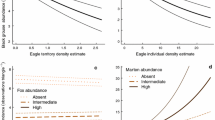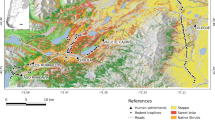Abstract
It has been suggested that predators may protect human health through reducing disease-host densities or selectively preying on infected individuals from the population. However, this has not been tested empirically. We hypothesized that Tengmalm’s owl (Aegolius funereus) selectively preys on hantavirus-infected individuals of its staple prey, the bank vole (Myodes glareolus). Bank voles are hosts of Puumala hantavirus, which causes a form of hemorrhagic fever in humans. Selective predation by owls on infected voles may reduce human disease risk. We compared the prevalence of anti-Puumala hantavirus antibodies (seroprevalence), in bank voles cached by owls in nest boxes to seroprevalence in voles trapped in closed-canopy forest around each nest box. We found no general difference in seroprevalence. Forest landscape structure could partly account for the observed patterns in seroprevalence. Only in more connected forest patches was seroprevalence in bank voles cached in nest boxes higher than seroprevalence in trapped voles. This effect disappeared with increasing forest patch isolation, as seroprevalence in trapped voles increased with forest patch isolation, but did not in cached voles. Our results suggest a complex relationship between zoonotic disease prevalence in hosts, their predators, and landscape structure. Some mechanisms that may have caused the seroprevalence patterns in our results include higher bank vole density in isolated forest patches. This study offers future research potential to shed further light on the contribution of predators and landscape properties to human health.





Similar content being viewed by others
References
Adler GH, Levins R (1994) The island syndrome in rodent populations. Q Rev Biol 69:473–490
Amman BR, Manangan AP, Flietstra TD, Calisher CH, Carrol DS, Wagoner KD, Mills JN (2013) Association between movement and Sin Nombre virus (Bunyaviridae: Hantavirus) infection in North American deermice (Peromyscus maniculatus) in Colorado. J Wildl Dis 49:132–142
ESRI ArcGIS (2013). Version 10. Environmental Systems Research Institute, Redlands, CA
Bates D, Maechler M, Bolker B, Walker S (2014) lme4: linear mixed-effects models using Eigen and S4. R package version 1.1-6. http://CRAN.R-project.org/package=lme4
Bender DJ, Tischendorf L, Fahrig L (2003) Usimg patch isolation metrics to predict animal movement in binary landscapes. Landsc Ecol 18:17–39
Brown JS, Kotler BP, Smith RJ, Wirtz WO (1988) The effects of owl predation on the foraging behavior of heteromyid rodents. Oecologia 76:408–415
Brummer-Korvenkontio M, Vaheri A, Hovi T, von Bonsdorff CH, Vuorimies J, Manni T, Penttinen K, Oker-Blom N, Lähdevirta J (1980) Nephropathia epidemica: detection of antigen in bank voles and serologic diagnosis of human infection. J Infect Dis 141:131–134
Deter J, Chaval Y, Galan M, Gauffre B, Morand S, Henttonen H, Laakkonen J, Voutilainen L, Charbonnel N, Cosson JF (2008) Kinship, dispersal and hantavirus transmission in bank and common voles. Arch Virol 153:435–444
Dizney L, Dearing MD (2013) The role of behavioral heterogeneity on infection patterns: implications for pathogen transmission. Anim Behav 86:911–916
Ecke F, Löfgren O, Sörlin D (2002) Population dynamics of small mammals in relation to forest age and habitat factors in northern Sweden. J Appl Ecol 39:781–792
Ecke F, Magnusson M, Hörnfeldt B (2013) Spatio-temporal changes in the landscape structure of forests in northern Sweden. Scand J For Res 28:651–667. doi:10.1080/02827581.2013.822090
Escutenaire S, Chalon P, De Jaegere F, Karelle-Bui L, Mees G, Brochier B, Rozenfeld F, Pastoret PP (2002) Behavioral, physiologic, and habitat influences on the dynamics of Puumala virus infection in bank voles (Clethrionomys glareoulus). Emerg Infect Dis 8:930–936
Estrada-Peña A, Ostfeld RS, Townsend Peterson A, Poulin R, de la Fuente J (2014) Effects of environmental change on zoonotic disease risk: an ecological primer. Trends Parasitol 30:205–214
Gortazar C, Reperant LA, Kuiken T, de la Fuente J, Boadella M, Martínez-Lopez B, Ruiz-Fons F, Estrada Peña A, Drosten C, Medley G (2014) Crossing the interspecies barrier: opening the door to zoonotic pathogens. PLoS Pathog 10:e1004129. doi:10.1371/journal.ppat.1004129
Hipkiss T, Gustafsson J, Eklund U, Hörnfeldt B (2013) Is the long-term decline of boreal owls in Sweden caused by avoidance of old boxes? J Raptor Res 47:15–20
Hörnfeldt B, Carlsson BG, Löfgren O, Eklund U (1990) Effects of cyclic food supply on breeding performance of Tengmalm’s owl. Can J Zool 68:522–530
Jones BA, Grace D, Kock R, Alonso S, Rushton J, Said MY, McKeever D, Mutua F, Young J, McDermott J, Pfeiffer DU (2013) Zoonosis emergence linked to agricultural intensification and environmental change. Proc Natl Acad Sci USA 110:8399–8404
Kallio ER, Poikonen A, Vaheri A, Vapalahti O, Henttonen H, Koskela E, Mappes T (2006) Maternal antibodies postpone hantavirus infection and enhance individual breeding success. Proc R Soc B 273:2771–2776
Kallio ER, Voutilainen L, Vapalahti O, Vaheri A, Henttonen H, Koskela E, Mappes T (2007) Endemic hantavirus infection impairs the winter survival of its rodent host. Ecology 88:1911–1916
Kallio ER, Begon M, Henttonen H, Koskela E, Mappes T, Vaheri A, Vapalahti O (2009) Cyclic hantavirus epidemics in humans—predicted by rodent host dynamics. Epidemics 1:101–107
Khalil H, Olsson G, Ecke F, Evander M, Hjertqvist M, Magnusson M, Ottosson-Löfvenius M, Hörnfeldt B (2014) The importance of bank vole density and rainy winters in predicting Nephropathia epidemica incidence in Northern Sweden. PLoS One 9:e111663. doi:10.1371/journal.pone.0111663
Klemola T, Korpimäki E, Norrdahl K, Tanhuanpää M, Koivula M (1999) Mobility and habitat utilization of small mustelids in relation to cyclically fluctuating prey abundances. Ann Zool Finn 36:75–82
Koivunen V, Korpimäki E, Hakkarainen H (1996) Differential avian predation on sex and size classes of small mammals: doomed surplus or dominant individuals. Ann Zool Fenn 33:293–301
Korpimäki E (1987) Prey caching of breeding Tengmalm’s owls (Aegolius funereus) as a buffer against temporary food shortage. Ibis 129:499–510
Kozakiewicz M (1985) The role of habitat isolation in formation of structure and dynamics of bank vole populations. Acta Theriol 30:193–209
Lee HW, Lee PW, Johnson KM (1978) Isolation of the etiologic agent of Korean hemorrhagic fever. J Infect Dis 137:298–308
Levi T, Kilpatrick AM, Mangel M, Wilmers CC (2012) Deer, predators, and the emergence of Lyme disease. Proc Natl Acad Sci USA 107:10942–10947
Lindkvist M, Näslund J, Ahlm C, Bucht G (2008) Cross-reactive and serospecificepitopes of nucleocapsid proteins of three hantaviruses: prospects for new diagnostic tools. Virus Res 137:97–105
Magnusson M, Ecke F, Khalil H, Olsson G, Evander M, Niklasson B, Hörnfeldt B (2015a) Spatial and temporal variation of hantavirus bank vole infection in managed forest landscapes. Ecosphere 6: Article 163
Magnusson M, Hörnfeldt B, Fr Ecke (2015b) Evidence for different drivers behind long-term decline and depression of density in cyclic voles. Popul Ecol 57:569–580
Mills JN (2006) Biodiversity loss and emerging infectious disease: an example from the rodent-borne hemorrhagic fevers. Biodiversity 7:9–17
Niklasson B, Hönrfeldt B, Lundkvist Å, Björnsten S, LeDuc J (1995) Temporal dynamics of Puumala virus antibody prevalence in voles and Nephropathia epidemica incidence in humans. Am J Trop Med Hyg 53:134–140
Norberg Å (1970) Hunting technique of Tengmalm’s owls Aegolius funereus (L.). Ornis Scand 1:51–64
Norrdahl K, Korpimäki E (1998) Does mobility or sex of voles affect risk of predation by mammalian predators? Ecology 79:226–232
Olsson GE, Ahlm C, Elgh F, Verlemyr A, White N, Juto P, Palo RT (2003) Hantavirus antibody occurrence in bank voles (Clethrionomys glareolus) during a vole population cycle. J Wildl Dis 39:299–305
Olsson GE, White N, Hjälten J, Ahlm C (2005) Habitat factors associated with bank voles (Clethrionomys glareolus) and concominant hantavirus in Northern Sweden. Vector Borne Zoonotic Dis 5:315–323
Olsson GE, Hjertqvist M, Lundkvist Å, Hörnfeldt B (2009) Predicting high risk for human hantavirus infections, Sweden. Emerg Infect Dis 15:104–106
Ostfeld RS, Holt RD (2004) Are predators good for your health? Evaluating evidence for top-down regulation of zoonotic disease reservoirs. Front Ecol Environ 2:13–20
Ostfeld RS, Keesing F (2000) The function of biodiversity in the ecology of vector-borne zoonotic diseases. Can J Zool 78:2061–2078
Ostfeld RS, Keesing F (2012) Effects of host diversity on infectious disease. Annu Rev Ecol Evol Syst 43:157–182
Pinheiro J, Bates D, Debroy S, Sarkar D, R Development Core Team (2013) nlme: linear and non-linear mixed effects models. R Package version 3:1–109
Pusenius J, Ylönen H (1994) The effects of confinement on demography and spacing behavior in the bank vole Clethrionomys glareolus. Ann Zool Fenn 31:335–341
R Core Team (2013) R: a language and environment for statistical computing. R Foundation for Statistical Computing, Vienna. Available at: http://www.R-project.org/
Reil D, Imholt C, Eccard JA, Jacob J (2015) Beech fructification and bank vole population dynamics- Combined analyses of promoters of human Puumala virus infections in Germany. PLoS One 10:e0134124. doi:10.1371/journal.pone.0134124
Santangeli A, Hakkarainen H, Laaksonen T, Korpimäki E (2012) Homer range size is determined by habitat composition but feeding rate by food availability in male Tengmalm’s owls. Anim Behav 83:1115–1123
Tersago K, Vergagen R, Vapalahti O, Heyman P, Ducoffre G, Leirs H (2010) Hantavirus outbreak in Western Europe: reservoir host infection dynamics related to human disease patterns. Epidemiol Infect 139:381–390
Vapalahti O, Mustonen J, Lundkvist Å, Henttonen H, Plyusnin A, Vaheri A (2003) Hantavirus infections in Europe. Lancet 3:653–661
Voutilainen L, Savola S, Kallio ER, Laakkonen J, Vaheri A, Vapalahti O, Henttonen H (2012) Environmental change and disease dynamics: effects of intensive forest management on Puumala hantavirus infection in boreal bank vole populations. PLoS One 7:e39452. doi:10.1371/journal.pone.0039452
Voutilainen L, Sironen T, Tonteri E, Tuiskunen Bäck A, Razzauti M, Karlsson M, Wahlström M, Niemimaa J, Henttonen H, Lundkvist Å (2015) Life-long shedding of Puumala hantavirus in wild bank voles (Myodes glareolus). J Gen Virol. doi:10.1099/vir.0.000076 (in press)
Ylönen H, Mappes T, Viitala J (1990) Different demography of friends and strangers: an experiment on the impact of kinship and familiarity in Clethrionomys glareolus. Oecologia 83:333–337
Acknowledgments
We thank Åke Nordström and Niklas Paulsson for their help in surveying nest boxes, and collecting and trapping voles on multiple occasions. We also thank Gert Olsson and Joris Cromsigt for insightful discussions. This study was funded by the Swedish Research Council Formas (grant no. 221-2012-1568) http://www.formas.se/.
Author contribution statement
B. H. conceived the idea, which was further developed with input from F. E. and H. K. H. K. collected and analyzed the data and wrote the manuscript. M. E. analyzed the samples. B. H., F. E., and M. E. contributed to the interpretation and discussion of the results.
Author information
Authors and Affiliations
Corresponding author
Additional information
Communicated by Janne Sundell.
Rights and permissions
About this article
Cite this article
Khalil, H., Ecke, F., Evander, M. et al. Selective predation on hantavirus-infected voles by owls and confounding effects from landscape properties. Oecologia 181, 597–606 (2016). https://doi.org/10.1007/s00442-016-3580-y
Received:
Accepted:
Published:
Issue Date:
DOI: https://doi.org/10.1007/s00442-016-3580-y




